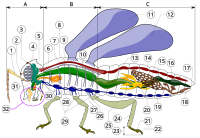
Life history responses of Hippodamia variegata (Coleoptera: Coccinellidae) to changes in the nutritional content of its prey, Aphis gossypii (Hemiptera: Aphididae), mediated by nitrogen fertilization
Sign Up to like & getrecommendations! Published in 2019 at "Biological Control"
DOI: 10.1016/j.biocontrol.2018.12.007
Abstract: Abstract The nutritional suitability of prey is an important determinant of predator fitness that can have a cascade of effects on life history. We manipulated the quality of cucumber plants by fertilizing them with three… read more here.
Keywords: aphis gossypii; hippodamia variegata; life history; life ... See more keywords

Lethal and sub-lethal effects of imidacloprid on the aphidophagous coccinellid hippodamia variegata.
Sign Up to like & getrecommendations! Published in 2019 at "Chemosphere"
DOI: 10.1016/j.chemosphere.2019.05.037
Abstract: Hippodamia variegata is one of the most abundant ladybird species in Greece, preying on several aphid species and other arthropods, of which many are pests of cultivated plants. Imidacloprid, a neonicotinoid insecticide, is commonly used… read more here.
Keywords: lethal effects; effects imidacloprid; sub lethal; rate ... See more keywords

Antenna-Biased Odorant Receptor HvarOR25 in Hippodamia variegata Tuned to Allelochemicals from Hosts and Habitat Involved in Perceiving Preys.
Sign Up to like & getrecommendations! Published in 2022 at "Journal of agricultural and food chemistry"
DOI: 10.1021/acs.jafc.1c05593
Abstract: Odorant receptors (ORs) of ladybird Hippodamia variegata play vital chemosensory roles in searching and locating preys. In the current study, 37 ORs were initially identified from the antennal transcriptome of H. variegata. The quantitative polymerase… read more here.
Keywords: allelochemicals hosts; hippodamia variegata; hvaror25; antenna biased ... See more keywords

Odorant-Binding Protein HvarOBP5 in Ladybird Hippodamia variegata Regulates the Perception of Semiochemicals from Preys and Habitat Plants.
Sign Up to like & getrecommendations! Published in 2023 at "Journal of agricultural and food chemistry"
DOI: 10.1021/acs.jafc.2c07355
Abstract: A total of 12 OBPs were identified in the antennae of ladybird Hippodamia variegata. HvarOBP1/2/5/6/10/11 were highly expressed in adults, whereas HvarOBP3/4/7/8/9/12 had higher expression levels in larvae. In adults, HvarOBP1/2/4/5/6/7/8/11/12 were highly expressed in… read more here.
Keywords: ladybird hippodamia; hexyl hexanoate; preys habitat; hippodamia variegata ... See more keywords

Functional morphology of antennae and sensilla of Hippodamia variegata (Coleoptera: Coccinellidae)
Sign Up to like & getrecommendations! Published in 2020 at "PLoS ONE"
DOI: 10.1371/journal.pone.0237452
Abstract: The lady beetle Hippodamia variegata is an important biocontrol agent of many aphids. In this study, the fine morphology of antennae as well as the typology, morphology and distribution of antennal sensilla were comprehensively examined… read more here.
Keywords: sensilla; morphology antennae; morphology; functional morphology ... See more keywords

Satellitome Analysis in the Ladybird Beetle Hippodamia variegata (Coleoptera, Coccinellidae)
Sign Up to like & getrecommendations! Published in 2020 at "Genes"
DOI: 10.3390/genes11070783
Abstract: Hippodamia variegata is one of the most commercialized ladybirds used for the biological control of aphid pest species in many economically important crops. This species is the first Coccinellidae whose satellitome has been studied by… read more here.
Keywords: ladybird beetle; analysis ladybird; satellitome analysis; hippodamia variegata ... See more keywords

Intraguild Predation between Chrysoperla carnea (Neuroptera: Chrysopidae) and Hippodamia variegata (Coleoptera: Coccinellidae) at Various Extraguild Prey Densities and Arena Complexities
Sign Up to like & getrecommendations! Published in 2020 at "Insects"
DOI: 10.3390/insects11050288
Abstract: Intraguild predation (IGP) is a ubiquitous, important and common interaction that occurs in aphidophagous guilds. The effects of extraguild prey (EGP, i.e., aphids) density, predator life stage combinations and duration of the interaction on the… read more here.
Keywords: carnea; extraguild prey; intraguild predation; hippodamia variegata ... See more keywords